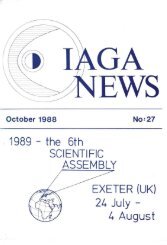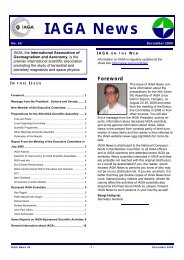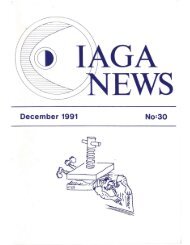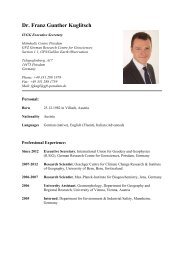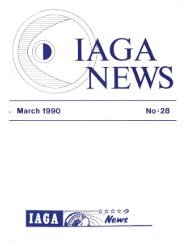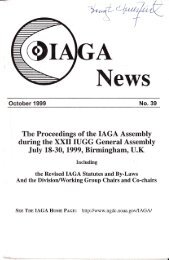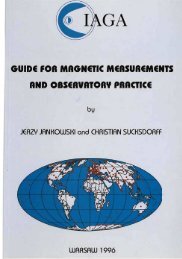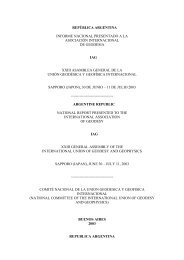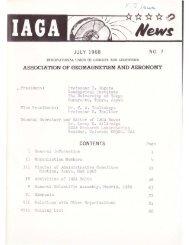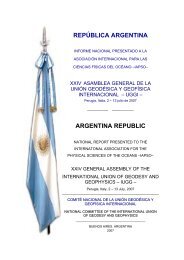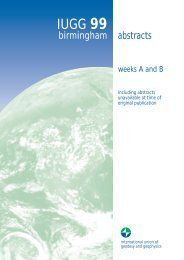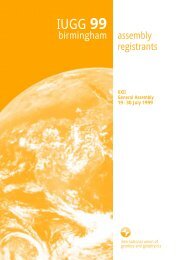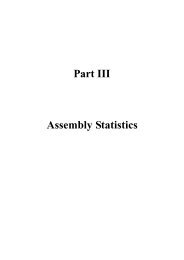IAGA News 2011 - IUGG
IAGA News 2011 - IUGG
IAGA News 2011 - IUGG
Create successful ePaper yourself
Turn your PDF publications into a flip-book with our unique Google optimized e-Paper software.
an ice cap hundreds of millions of years ago. And this is<br />
by no means an exhaustive list.<br />
Dedicated as he was to his own research, Ian was also<br />
committed to playing a leadership role in the scientific<br />
community at large. He served as President of <strong>IAGA</strong>,<br />
President of the Canadian Geophysical Union, and as Director<br />
of the Institute of Earth and Planetary Physics<br />
(now the Institute for Geophysical Research) at the University<br />
of Alberta. He was also instrumental in setting up<br />
Canada’s highly-acclaimed national geosciences program<br />
Lithoprobe. Ian Gough’s contributions to geoscience were<br />
recognized nationally and internationally. He was awarded<br />
the Canadian Geophysical Union’s J. Tuzo Wilson Medal<br />
(1983), theRoyalAstronomicalSociety’s ChapmanMedal<br />
(1988), and the South African Geophysical Association’s<br />
Rudolf Krahmann Medal (1989). He was also a Fellow of<br />
the Royal Society of Canada, the American Geophysical<br />
Union, and the Geological Association of Canada.<br />
During his last field work in South Africa, Ian discovered<br />
a taste for writing poetry and after his retirement turned<br />
to that. He remarked more than once that doing this was<br />
more difficult than geophysical research! Nevertheless, in<br />
2006 he published ‘Signing the Light’, a book of poetry<br />
that reveals a sensitive and caring nature. Ian was always<br />
a thoughful and courteous colleague, mentor, and friend.<br />
He inspired and unfailingly supported generations of students,<br />
post-doctoral fellows, and younger faculty members.<br />
His passing is a great loss to us all, but his example<br />
of a life well lived, of commitment and service, is a legacy<br />
of which we are all the beneficiaries.<br />
Ted Evans<br />
University of Alberta, Edmonton, Canada<br />
Wilfried Schröder (1941 - <strong>2011</strong>)<br />
Wilfried Schröder, Topical Editor of the journal ‘History<br />
of Geo- and Space Sciences’, passed away on 12 April<br />
<strong>2011</strong>. He was born on 10 August 1941 in Bremen. He<br />
studied mathematics, physics, and geophysics at the Universities<br />
of Göttingen, Berlin and Münster and became<br />
a highschool teacher. From the very beginning of his<br />
studies he got interested in science history. Around 1960<br />
he founded the ‘Geophysikalische Forschungsstation’ in<br />
Bremen-Röönnebeck as a one-person business. He undertook<br />
observations on noctilucent clouds and aurora, but<br />
his main work was the publication of books and scientific<br />
articles on science history. He received a doctoral<br />
degree from the University of Bremen in 1981. After an<br />
early retirement from his teaching duties he could fully<br />
concentrate on his scientific interests. These were very<br />
widespread, touching almost all fields of external geophysics<br />
history, but mainly auroral research, solar terrestrial<br />
relations, geomagnetism, upper atmospheric physics,<br />
and noctilucent clouds.<br />
In the 1980s Schröder became involved in the Interdivisional<br />
Commission on History of <strong>IAGA</strong>. According to<br />
a friend he ‘constructed’ this Commission: “I remember<br />
whenitssessionshadatmost10-20participants,including<br />
the relatives of the speakers. After his great involvement<br />
in promoting historical studies, I found that it became<br />
eventually embarrassing (we were in Birmingham) realizing<br />
that a room with a few hundred seats was insufficient,<br />
and several people were listening to the session out of the<br />
door. This was the result of Wilfried’s promotion!” The<br />
Interdivisional Commission on History of <strong>IAGA</strong> became a<br />
unique active body dealing with history of Earth sciences<br />
within the entire <strong>IUGG</strong>, not only of <strong>IAGA</strong>. He remained<br />
active in this Commission by convening sessions and other<br />
organizationalworkuntil2005. Inordertopublishandcirculate<br />
scientific contributions presented at the <strong>IAGA</strong> and<br />
<strong>IUGG</strong> symposia he founded his own publishing enterprise<br />
‘Science Edition-Potsdam/Bremen’financed mostly with<br />
his own money. Many well recognized books were published<br />
in this edition, like Das Phänomen des Polarlichts,<br />
1984; Noctilucent Clouds and Mesosphere: a historical<br />
Review, 2007; Einstein und die Geophysik, 2004; The aurora<br />
in time, 2000. His aim was to publish inexpensive<br />
books, in order that they could have a great circulation,<br />
and to give many authors an opportunity to publish their<br />
work. In this endeavour, Schröder never had any institutional<br />
support. Besides, based on his own research,<br />
he published more than 200 papers in well-known peerreviewed<br />
journals.<br />
He was particularly interested in the origin and development<br />
of new scientific ideas and in the scientists involved,<br />
and was fascinated by the search for the intellectual steps<br />
of past scientists who left a heritage to us with their wisdom<br />
and achievements. He thus published several articles<br />
on well-known physicists and geophysicists, like Hermann<br />
Fritz, Alfred Wegener, Emil Wiechert, Albert Einstein,<br />
Arnold Sommerfeld, and Werner Heisenberg. He<br />
also maintained a correspondence with Sidney Chapman<br />
and with the philosopher Karl Popper. Even before German<br />
reunification, Schröder kept close contact and a vivid<br />
correspondence with important scientists of the former<br />
GDR, like Hans-Jürgen Treder (theoretical physics) and<br />
Hans Ertel (geophysical hydrodynamics). Together with<br />
Treder he founded the ‘Arbeitskreis Geschichte der Geophysik<br />
und Kosmischen Physik’ (German Commission on<br />
History of Geophysics and Cosmical Physics). He was not<br />
only active in the <strong>IAGA</strong> History Commission but also a<br />
member of several other scientific organizations and societies:<br />
Deutsche Geophysikalische Gesellschaft, Deutsche<br />
Physikalische Gesellschaft, Leibniz-Societät, Max-Planck<br />
Gesellschaft, American Geophysical Union, and INHIGEO<br />
(International Commission on the History of Geological<br />
Sciences). Schröder’s experience and international contacts<br />
were very important and valuable in establishing the<br />
journal: History of Geo- and Space Sciences. Wilfried<br />
Schröder will be missed by many, including the authors of<br />
this obituary and other scientists who shared his deep and<br />
abiding interest in historical matters.<br />
K. Schlegel<br />
Copernicus Gesellschaft e.V., Göttingen, Germany<br />
and<br />
G. Gregori<br />
Institute of Acoustics ”O. M. Corbino”, Rome, Italy<br />
Bhisham Prasad Singh (1937 - <strong>2011</strong>)<br />
Bhisham Prasad Singh was born on August 18, 1937 in<br />
Bihar, India. He obtained an M.Sc. degree from Bihar<br />
University, and a Ph.D. degree from Queens University,<br />
Canada in 1972. From 1958 to 1965 he worked as a<br />
Lecturer at Ranchi University, Bihar. He was a Scientist<br />
<strong>IAGA</strong> <strong>News</strong> <strong>2011</strong> – Page 11



